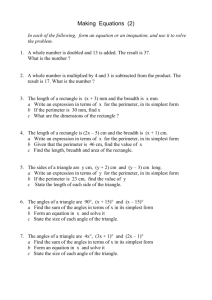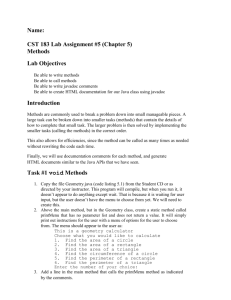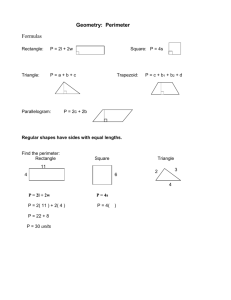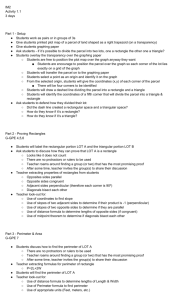Ch. 2, Section 4
advertisement
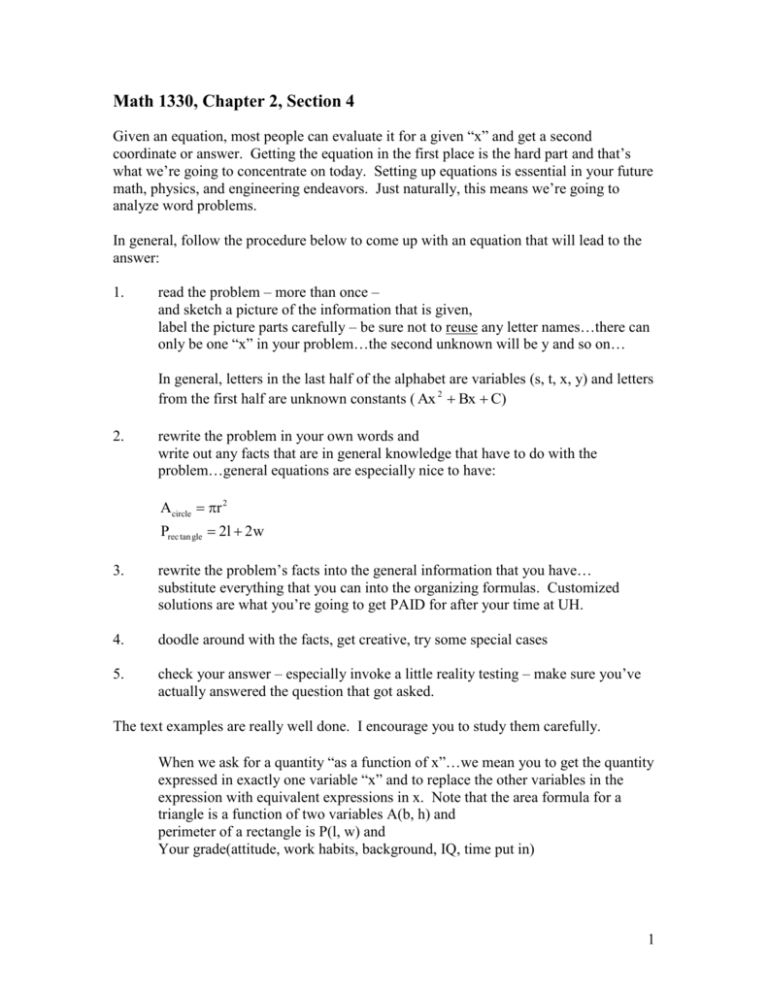
Math 1330, Chapter 2, Section 4 Given an equation, most people can evaluate it for a given “x” and get a second coordinate or answer. Getting the equation in the first place is the hard part and that’s what we’re going to concentrate on today. Setting up equations is essential in your future math, physics, and engineering endeavors. Just naturally, this means we’re going to analyze word problems. In general, follow the procedure below to come up with an equation that will lead to the answer: 1. read the problem – more than once – and sketch a picture of the information that is given, label the picture parts carefully – be sure not to reuse any letter names…there can only be one “x” in your problem…the second unknown will be y and so on… In general, letters in the last half of the alphabet are variables (s, t, x, y) and letters from the first half are unknown constants ( Ax 2 Bx C) 2. rewrite the problem in your own words and write out any facts that are in general knowledge that have to do with the problem…general equations are especially nice to have: Acircle r 2 Prec tan gle 2l 2w 3. rewrite the problem’s facts into the general information that you have… substitute everything that you can into the organizing formulas. Customized solutions are what you’re going to get PAID for after your time at UH. 4. doodle around with the facts, get creative, try some special cases 5. check your answer – especially invoke a little reality testing – make sure you’ve actually answered the question that got asked. The text examples are really well done. I encourage you to study them carefully. When we ask for a quantity “as a function of x”…we mean you to get the quantity expressed in exactly one variable “x” and to replace the other variables in the expression with equivalent expressions in x. Note that the area formula for a triangle is a function of two variables A(b, h) and perimeter of a rectangle is P(l, w) and Your grade(attitude, work habits, background, IQ, time put in) 1 Problem 1: The sum of two numbers is 5. The difference of the squares is, too. What is the product of the numbers? What’s the first number? And the second? What are the facts of the problem? The sum The difference of the squares VS the square of the differences Now we’re at the doodling part: So, did we answer the question when we got x? 2 Problem 2: Given f ( x ) x 3 , x 0 . By selecting any point, x, with x > 0, you can sketch a right triangle using two segments, one from the origin to a point on the curve, then another straight down to the x axis. Calculus alert: Being able to recast y in its functional form is a survival skill in this section! It’s not (x, y); it’s (x, f(x)). What is the area of the triangle in terms of the variable x? What is the perimeter of the triangle in terms of the variable x? 3 Problem 3 A. The perimeter of a rectangle is 54 feet. Express its area as a function of its width, w. Perimeter is a function in TWO variables, you are to reduce it to one variable for this problem…this work is quite often problem specific and not general in nature… B. The area of a rectangle is 54 ft2. Express its perimeter as a function of its width. 4 Problem 4: Suppose you have a circle centered at the origin. If you sketch a rectangle in the upper half plane with its base on the x axis and the two upper corners on the circle, what are the area and perimeter in terms of x? Hint the formula for the circle is x 2 y 2 r 2 with r a positive constant. Note that x and y are variables and r is a constant, a number that is fixed. There’s a whole lot to this problem. Let’s sketch it first: Note that we’ll have to use some geometric facts! What are the formulas for area and perimeter of a rectangle? Let’s fill them in with the facts from the problem: Now are there some restrictions on which x’s I can use? Then let’s say those, too. We need to use x . So here’s the whole answer, all in terms of x A(x) = P(x) = 5 Problem 5: [these two are Real Calculus types] A. A wire of length x is bent into the shape of a circle. Express the circumference in terms of x. Express the area in terms of x B. The hypotenuse of a right triangle is 8 feet. Express the area of the triangle as a function of x, the length of one of the legs. Hint: put a coordinate system on the triangle! Calc and Physics note: you can do this freely; just be consistent with your subsequent notations and facts. 6 Problem 6: The base of a rectangle lies on the x axis, while the upper vertices line on the parabola f ( x ) 10 x 2 . Express the area of the rectangle as a function of x. Sketch the picture, label and fill in as much as possible What are some other facts pertinent to the problem? Again, we need x . Doodle some: The answer is: 7 Problem 7 A. Let P be a point on the graph f (x ) x 2 7 . Express the distance from P to the origin as a function of x. B. On your own: Express the distance from P to the point ( 0, 3) as a function of x. Answer: 8 Problem 8: Another one that is really jumping into Calculus turf Let A denote the area of a right triangle in the first quadrant formed by the y axis and the lines y = m and y = mx, for m >0. Express the area of the triangle as a function of m. 9 Problem 9: Suppose that P is a point on the line y = 3x 1. And Q is the point ( 1, 3). Express the distance from P to Q as a function of x. Problem 10: If the sum of two numbers is 8, find the largest possible value of their product. 10

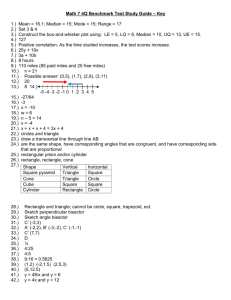
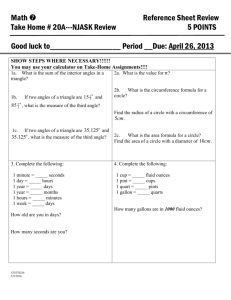
![Application Problem for MATH 1401 [Calculus I]](http://s3.studylib.net/store/data/007358853_1-dd6cc08c81147ef64e1b411c00194d67-300x300.png)

